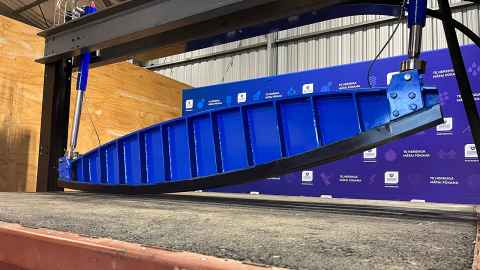A partnership between Waipapa Taumata Rau and Downer NZ could spell the beginning of the end for “range anxiety”.


Researchers from Waipapa Taumata Rau, University of Auckland in collaboration with Downer have launched a new facility that could be a game-changer in the uptake of electric vehicles (EVs) in Aotearoa New Zealand.
The Accelerated Pavement Test (APT) “rocker” facility located at Downer’s Auckland asphalt plant has been developed over the past four years to test the effectiveness of wireless “in-pavement” charging for EVs.
The facility will help researchers from the Faculty of Engineering to investigate the potential for integrating wireless charging pads into roads and highways, so drivers won’t need to plug-in to charge their EVs.
It could spell the beginning of the end for “range anxiety” – a term used to describe an EV driver’s fear that their battery will run out of power before they reach their destination.
“This facility will help us model and assess the complex mechanical, electrical and thermal interactions when a wireless power system is placed within different pavement designs, says Professor Grant Covic, who leads the research team.
“It will enable us to find the best fit and lowest cost solutions suitable for New Zealand roads.”
The launch is part of the Inductive Power Transfer (IPT) Roadway Project funded by MBIE, which aims to develop new ways to charge Aotearoa New Zealand’s fleet of EVs to meet emission reduction targets.


The University of Auckland is home to a world-leading team who have been researching wireless charging technology for over 20 years. As Aotearoa New Zealand moves to a low carbon future, the electrification of our roads is becoming increasingly urgent but there are challenges to making this technology viable for widespread use.
The partnership between the University of Auckland and Downer brings us one step closer to overcoming those challenges, says Murray Robertson, CEO of Downer NZ.
“We’re proud to enable the development of solutions that will work in the real world. Having this technology integrated into infrastructure will help us meet our shared low carbon goals and ensure the future durability and resilience of our roading network. Downer is committed to supporting innovation that could change how we build pavements in future and accelerate the adoption of electric vehicles,” says Robertson.
The Accelerated Pavement Test (APT) “rocker” facility will simulate the wheel of a truck running over a half-scale road pavement with integrated wireless pads and is designed to simulate pavement or pad fatigue over time. It will help researchers to fully test our future roads, as well as their resilience to environmental conditions.
“The system was co-developed by utilising the mechanical, roading and electrical expertise across the University and Downer teams,” says Dr Tom Allen. “It will enable faster testing of durable charging systems, which is a key factor in the system’s success.”
Providing durable “in-pavement” solutions is a challenging but very worthwhile goal, says Associate Professor Doug Wilson, Director of the Transportation Research Centre at the University of Auckland.
“This project will have significant benefits for a potential future transport system, and integrating new technologies like this will be invaluable as New Zealand transitions to a low carbon future.”







































